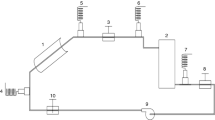Abstract
Parabolic trough collectors (PTCs) are employed for a variety of applications including steam generation and hot water generation. This paper deals with the experimental results and an economic analysis of a new fibre reinforced plastic (FRP) based solar PTC with an embedded electronic controlled tracking system designed and developed for hot water generation in a restaurant in Madurai, India. The new collector performance has been tested according to ASHRAE Standard 93 (1986). The performance of a new PTC hot water generation system with a well mixed hot water storage tank is investigated by a series of extensive tests over ten months period. The average maximum storage tank water temperature observed was 74.91 °C, when no energy is withdrawn from the tank to the load during the collection period. The total cost of the new economic FRP based solar PTC for hot water generation with an embedded electronic controlled tracking system is Rs. 25000 (US$ 573) only. In the present work, life cycle savings (LCS) method is employed for a detailed economic analysis of the PTC system. A computer program is used as a tool for the economic analysis. The present worth of life cycle solar savings is evaluated for the new solar PTC hot water generation system that replaces an existing electric water heating system in the restaurant and attains a value of Rs. 23171.66 after 15 years, which is a significant saving. The LCS method and the MATLAB computer simulation program presented in this paper can be used to estimate the LCS of other renewable energy systems.
Similar content being viewed by others
References
Ardente, F., Beccali, G., Cellura, M., lo Brano, V., 2005. Life cycle assessment of a solar thermal collector. Renewable Energy, 30(7):1031–1054. [doi:10.1016/j.renene.2004.09.009]
ASHRAE Standard 93, 1986. Method of Testing to Determine the Thermal Performance of Solar Collectors. American Society of Heating, Refrigerating and Air-Conditioning Engineers, Atlanta, GA.
Crawford, R.H., Treloar, G.J., 2004. Net energy analysis of solar conventional domestic hot water systems in Melbourne, Australia. Solar Energy, 76(1–3):159–163. [doi:10.1016/j.solener.2003.07.030]
Kablan, M.M., 2004. Techno-economic analysis of the Jordanian solar water heating system. Energy, 29(7):1069–1079. [doi:10.1016/j.energy.2004.01.003]
Kalogirou, S., 1996. Economic Analysis of Solar Energy Systems Using Spreadsheets. Proceedings of the 4th World Renewable Energy Congress. Denver, Colorado, USA, p.1303–1307.
Kalogirou, S., Lloyd, S., 1992. Use of solar parabolic trough collectors for hot water production in Cyprus—A feasibility study. Renewable Energy, 2(2):117–124. [doi:10.1016/0960-1481(92)90097-M]
May, E.K., Murphy, L.M., 1983. Performance benefits of the direct generation of steam in line-focus solar collectors. Journal of Solar Energy Engineering, 105:126–133.
MNES (Ministry of Non-conventional Energy Sources, India), 2006. http://mnes.nic.in/snov02.html
Stoecker, W.F., 1989. Design of Thermal Systems (3rd Edition). McGraw-Hill Book Company, Singapore.
Sukhatme, S.P., 2003. Solar Energy—Principles of Thermal Collection and Storage (2nd Ed.). Tata McGraw-Hill Publishing Company Limited, New Delhi.
TERI (Tata Energy Research Institute), 2001. Survey of Renewable Energy in India. TERI Project Report No. 2000RT45, New Delhi, p.50.
TNEB (Tamilnadu Electricity Board, India), 2005. http://www.tnebnet.org/tariff.html
Tiwari, G.N., 2002. Solar Energy—Fundamentals, Design, Modelling and Applications. Narosa Publishing House, New Delhi.
Tsilingiridis, G., Martinopoulos, G., Kyriakis, N., 2004. Life cycle environmental impact of a thermosyphonic domestic solar hot water system in comparison with electrical and gas water heating. Renewable Energy, 29(8):1277–1288. [doi:10.1016/j.renene.2003.12.007]
Valan Arasu, A., Sornakumar, T., 2005. Design and simulation analysis of a parabolic trough solar collector hot water generation system. International Energy Journal, 6(2): 13–25.
Valan Arasu, A., Sornakumar, T., 2006. Performance characteristics of parabolic trough solar collector system for hot water generation. International Energy Journal, 7(2): 137–145.
Valan Arasu, A., Sornakumar, T., 2007. Design, manufacture and testing of fiberglass reinforced parabola trough for parabolic trough solar collectors. Solar Energy, 81(10):1273–1279. [doi:10.1016/j.solener.2007.01.005]
Author information
Authors and Affiliations
Corresponding author
Rights and permissions
About this article
Cite this article
Valan Arasu, A., Sornakumar, T. Life cycle cost analysis of new FRP based solar parabolic trough collector hot water generation system. J. Zhejiang Univ. Sci. A 9, 416–422 (2008). https://doi.org/10.1631/jzus.A072134
Received:
Accepted:
Published:
Issue Date:
DOI: https://doi.org/10.1631/jzus.A072134
Key words
- Economic analysis
- Life cycle savings
- Life cycle cost (LCS)
- Parabolic trough collector (PTC)
- Solar water heating system (SWHS)




